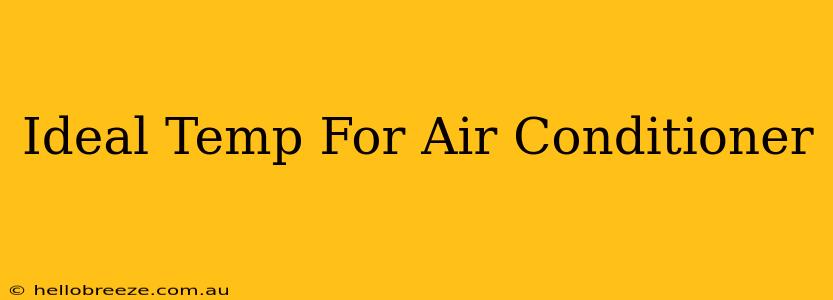Finding the perfect air conditioner temperature can feel like a Goldilocks quest – too hot, too cold, just right! But striking that balance isn't just about personal preference; it significantly impacts your comfort and your energy bills. This guide will help you determine the ideal temperature setting for your AC unit, maximizing both comfort and energy efficiency.
Understanding the Ideal AC Temperature Range
While the "perfect" temperature is subjective and depends on individual preferences and activity levels, energy experts generally recommend setting your air conditioner between 78°F (26°C) and 80°F (27°C) when you're home and awake. This range offers a comfortable environment while minimizing energy consumption.
Factors Influencing Your Ideal Temperature
Several factors play a crucial role in determining your ideal AC temperature:
-
Personal Preference: Some people prefer cooler temperatures than others. Experiment to find the temperature that feels most comfortable to you without shivering or sweating.
-
Activity Level: If you're engaging in strenuous activities, you might prefer a slightly cooler temperature. Conversely, if you're relaxing or sleeping, a slightly warmer temperature may suffice.
-
Humidity Levels: High humidity makes the air feel warmer than it actually is. Consider using a dehumidifier in conjunction with your AC to enhance comfort, even at slightly warmer temperatures.
-
Health Conditions: Certain health conditions can make individuals more sensitive to temperature changes. Consult your doctor if you have concerns about your ideal AC temperature.
-
Time of Day: You might prefer a slightly cooler temperature during the hottest part of the day and a warmer setting at night while sleeping.
Energy Efficiency and Temperature Settings
Setting your thermostat even a few degrees higher can significantly reduce your energy consumption. For every degree you raise the thermostat, you can save approximately 1% on your cooling costs. This seemingly small change can add up to substantial savings over time.
Smart Thermostats: Optimizing Energy Use
Smart thermostats offer advanced features that automatically adjust your AC temperature based on your usage patterns, occupancy, and even weather conditions. These thermostats can learn your preferences and optimize energy use accordingly, leading to even greater savings.
Tips for Maximizing Comfort and Energy Savings
Beyond the thermostat setting, several other measures can improve your comfort and reduce energy waste:
-
Proper Insulation: Ensure your home is well-insulated to prevent heat from entering and cool air from escaping.
-
Seal Air Leaks: Caulk and weatherstrip windows and doors to prevent drafts.
-
Use Fans Strategically: Ceiling fans and portable fans can help circulate air and make you feel cooler, allowing you to set the thermostat a few degrees higher.
-
Close Curtains and Blinds: Block sunlight from entering your home during the hottest parts of the day to reduce heat gain.
-
Regular AC Maintenance: Schedule regular maintenance checks to ensure your air conditioner is running efficiently.
Conclusion: Finding Your Perfect Temperature Balance
The ideal AC temperature is a personal choice, influenced by numerous factors. However, by understanding the recommended temperature range and implementing energy-saving practices, you can create a comfortable and energy-efficient indoor environment. Remember to experiment and find the temperature that feels best for you while still being mindful of your energy consumption. Striking this balance will lead to both greater comfort and lower energy bills.

